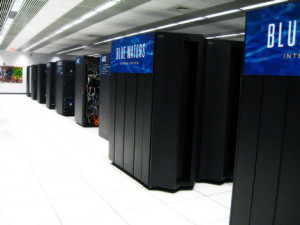“Agrivoltaic,” a portmanteau of agriculture and photovoltaic, describes crop fields that include photovoltaic solar panels. It’s an efficient proposition – both crops and solar power benefit from ample sunlight – but requires a delicate balancing act to ensure a bountiful harvest of both resources. Now, a project funded by the U.S. Department of Agriculture (USDA) is poised to leverage both current- and next-gen systems at the National Center for Supercomputing Applications (NCSA) to optimize the designs of these hybrid fields.
The project was funded to the tune of $10 million over four years by the USDA’s National Institute of Food and Agriculture (NIFA). It will be led by Madhu Khanna, interim director of the Institute for Sustainability, Energy and Environment (iSEE) at the University of Illinois at Urbana-Champaign (UIUC), with UIUC as the lead institution as well.
The researchers will develop and study agrivoltaic fields in Arizona, Colorado and Illinois (selected in order to include a range of climates and land types) with the aim of optimizing for factors like land productivity, profitability and water-use efficiency. Part of the reason for the study, Khanna explained, is the tension between crop yields and energy production that can develop as the two compete for the same land resources. (In some countries, large photovoltaic arrays have even been prohibited from overtaking crop fields.)
“To produce solar energy at the utility scale is land intensive, and cropland is often the most suitable for this purpose,” Khanna said. “Agrivoltaics – co-locating energy and food production – has the potential to reduce this competition for land,” Khanna said. “Our proposed project … will provide a comprehensive analysis of the transformative potential of agrivoltaics. Our goal is to maintain or even increase crop yield, increase the combined (food and electricity) productivity of land and diversify and increase farmers’ profits with row crops, forage and specialty crops across a range of environments.”
NCSA, meanwhile, will support the agrivoltaics research through model development and through contributions to the Community Earth System Model (CESM).
“In this project, our team will develop models for the agrivoltaics systems, i.e. fitting solar panels to cropland to optimize the overall outcome of energy and food production.” explained Kaiyu Guan, a professor of ecohydrology at UIUC and one of the investigators on the project. “The team, including myself and Bin Peng, will use NCSA supercomputers to add new components to the [CESM], which will enable new simulations and scale them up to the broader, national scale, allowing the team to assess impacts, including how such a system would feedback to the regional climate under a changing climate.”

The supercomputers in question, Guan told HPCwire, are NCSA’s Blue Waters supercomputer and its forthcoming Delta system. Blue Waters’ 13 peak petaflops of compute power (NCSA opted not to run the Linpack benchmark on the system) made it one of the most powerful supercomputers in the world when it launched in 2013, and eight years later, the Cray-built, AMD- and Nvidia-powered system is still going strong, given its age.
But the agrivoltaics project will also be making use of NCSA’s Delta, a next-gen system that UIUC says will constitute the largest GPU resource in the NSF’s supercomputing portfolio when it launches. To that end, Delta will include 124 AMD Milan-based dual-CPU nodes; 100 nodes with four Nvidia 40GB A100 GPUs; 100 nodes with four Nvidia A40 GPUs; five nodes with eight 40GB A100s; and one node with eight AMD MI100 GPUs. (For those of you who don’t want to count, that’s 848 total GPUs.) Further, the system will include 7PB of disk storage, 3PB of flash storage and over 90TB of aggregate memory.
The timeline for Delta’s deployment is a bit hazy – a release from earlier this year set it for XSEDE allocation this summer – but by all appearances, NCSA’s next-gen system could start work any day now, if it hasn’t already, and formal acceptance is due by year end. (And this time, it might actually get a Linpack rating.)
For more information on Delta, watch this YouTube video.



























































